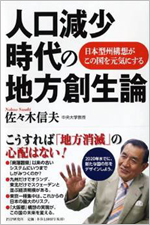Top>Opinion>Osaka Metropolis plan dissolved
 Index
Index

Nobuo Sasaki【profile】
Osaka Metropolis plan dissolved
Nobuo Sasaki
Professor, Faculty of Economics, Chuo University
Areas of Specialization: Political Science, Public Administration
Rejected in Local Referendum
The votes have been tallied for a local referendum in which 2,110,000 voters of Osaka City were directly asked if they would like to boldly move forward with the reforms of the Osaka Metropolis plan or keep things the way they are. Held on May 17, the referendum resulted in a 66.83% voter turnout, with 694,844 votes for and 705,585 against. The plan was defeated despite the narrow 0.76% margin of valid votes cast. Under the Act of Establishment of Special Wards in Large Urban Areas, the outcome of the local referendum was set to be determined by a majority of as few as one vote, regardless of voter turnout. As a result, the greater number of opposing votes has brought the Osaka Metropolis plan to a halt in its final phase, after five years of preparation by Mayor Toru Hashimoto and its other proponents.
Had the Plan Been Approved
If the majority of votes had been in favor of the plan, Osaka (Osaka-shi), a city with a more than 120 year history, would have been abolished in April 2017 after a roughly two-year preparation period, and the broader-based local government of Osaka-to (“Osaka Metropolis”—the name would change due to the legal revision) would have been formed in its place with five special wards, or basic municipalities, in the northern, coastal, eastern, southern, and central parts of the region. Thus, Osaka would have embarked on a new course as a “metropolis” like Tokyo. Over the last three years or so, I have been involved in Osaka’s institutional design as a special advisor to the city and prefectural governments. In view of the way Osaka’s decline has accelerated the concentration of the population in Tokyo, I hoped that Osaka would become a metropolis to stop the population trend and promote the development of Japanese land in a dispersed and polarized pattern under a two-metropolis system. From that perspective, the outcome of the referendum is extremely unfortunate.
So why the big fuss over the “Osaka Rebellion,” as some have called the plan? The answer lies in a dispute over the best method for curbing Osaka’s decline and the Kansai region’s loss of influence that have begun since the world fair held in Osaka in 1970. One option is to try to revitalize Osaka in its current state as a “designated city” with a population of 2,700,000, while another option is to abolish Osaka City, reorganize it as five special wards (municipalities), integrate regional administration to the prefectural government, and unify control centers for metropolitan strategy under the Osaka metropolitan (prefectural) government. The latter option is the method advanced for five years by main proponents Osaka Mayor Toru Hashimoto, Osaka Governor Ichiro Matsui, and the local party Osaka Restoration Association, ending with a local referendum to decide whether or not to go forward with the proposal.
Osaka is Japan’s second most populous urban region. The center of operations has been taken over by the city government, which doubles as the prefectural government. Although the prefectural government is supposed to be in charge of regional policy, in reality, it has been unable to interfere with matters within Osaka City. Geographically, Osaka Prefecture is also the narrowest prefecture after Kagawa, stretching out in a long thin strip from north to south. The designated city of Osaka lies right in the center of this region. Ostensibly for prefectural residents, the Osaka prefectural government constructs facilities in Osaka City, while Osaka City government, naturally, build various facilities in the city saying they are for city residents. The separately established but similar-looking facilities for the prefectural and city governments thus stand close together, drawing attention to Osaka’s problem of double administration and many overlapping services, such as subsidies and benefits for smaller companies and city residents. Furthermore, as a result of the authority over regional policy given to both prefectural and city governments, the prefectural governor and city mayor draw up conflicting development policies and ideas about Osaka’s role. Osaka has thus been plagued by a continuous struggle stemming from the “alignment of city and prefecture” (fushiawase, a homophone of ‘unhappiness’).
Osaka Metropolis Plan as Our Trump Card
From the perspective of administrative reform, the solution to this problem is to leave basic administration to special wards, organizing Osaka into five special wards (basic municipalities) managed by publicly elected ward mayors and assemblies that can provide a more detailed response, while returning regional administration to the prefectural government and unifying Osaka’s control centers under the Osaka prefectural (metropolitan) government office, as laid out in the Osaka Metropolis plan. Reform of Osaka’s administrative system was not originally at the core of the Osaka Metropolis plan. The idea was to have the prefecture (metropolis) take charge of large-scale improvement of infrastructure, urban development, and strategies for growth by integrating these areas under the command of the Osaka metropolitan governor. Once the government structure was changed, the prefecture would then implement strategies that would allow Osaka to compete with Tokyo and other global cities. The plan was based on the conviction that a strong government organization was absolutely necessary for developing and implementing metropolitan policies like strategies for growth and public infrastructure projects for the advancement of the city.
Controversy Based on a Misunderstanding
Despite this, party activism against the plan gathered momentum by the day, with everyone from the Liberal Democratic Party to the Communist Party joining forces to spread a negative campaign. They claimed that there was no double administration and that if Osaka City was abolished and replaced with special wards, Osaka’s power and financial resources would decline, and it would no longer be able to provide quality services. The campaign made inroads into the local referendum, with 70 percent of city residents feeling that “the explanation was insufficient.” My guess is that many of the dissenting votes represent the fearful cries of uninformed residents left in the dark.
Related Links:
- Regional Revitalization: Another Perspective

- Appointment of the New Governor

- Will Japan’s Politics Change After the End of the Divided Diet? Interpreting the Tokyo Metropolitan Assembly and Upper House Elections

- Reading the Lower House and Tokyo Gubernatorial Double Elections and the Upcoming Upper House Election

- Direction of Large City Reform - Osaka Metropolis Plan

- Reflections on the Tokyo Gubernatorial and Nationwide Local Elections

- Nobuo Sasaki
Professor, Faculty of Economics, Chuo University
Areas of Specialization: Political Science, Public Administration -

- Professor Sasaki was born in 1948. He earned a master’s degree from the Graduate School of Political Science, Waseda University and a doctorate in law from Keio University. After serving in the Tokyo Metropolitan Government Office, he became a professor at Seigakuin University in 1989 and a professor at Chuo University in 1994. He was a visiting research fellow at the University of California, Los Angeles (UCLA) in 2000 and has served as a professor in both the Graduate School of Economics and the Faculty of Economics at Chuo University from 2001 onward. He specializes in public administration and local self-government and serves as a member of organizations like the Science Council of Japan (in the field of political science) and the Japanese government’s 31st Local Government System Research Council. He also served as a special advisor to Osaka City and Osaka Prefecture until March this year. His recent publications include Regional Revitalization in an Era of Depopulation [Jinkō Genshō Jidai no Chihō Sōsei Ron] (PHP), The New Shape of Japan [Aratana “Nihon no Katachi”] (Kadokawa SSC Shinsho), The Governor of Tokyo: Power and the Tokyo Metropolitan Government [Tochiji – Kenryoku to Tosei] (Chuko Shinsho), and Local Assembly Members [Chihō Giin] (PHP Shinsho), among many others. He has received the NHK Local Broadcast Cultural Award and the Japan Society for Urbanology Prize. He frequently provides commentary for NHK and various newspapers and energetically continues to give lectures throughout Japan.
(Insert photo of cover for Regional Revitalization in an Era of Depopulation [Jinkō Genshō Jidai no Chihō Sōsei Ron])
- Research Activities as a Member of Research Fellowship for Young Scientists (DC1), Japan Society for the Promotion of Science (JSPS) Shuma Tsurumi
- Important Factors for Innovation in Payment Services Nobuhiko Sugiura
- Beyond the Concepts of Fellow Citizens and Foreigners— To Achieve SDGs Goal 10 “Reduce Inequality Within and Among Countries” Rika Lee
- Diary of Struggles in Cambodia Fumie Fukuoka
- How Can We Measure Learning Ability?
—Analysis of a Competency Self-Assessment Questionnaire— Yu Saito / Yoko Neha - The Making of the Movie Kirakira Megane








